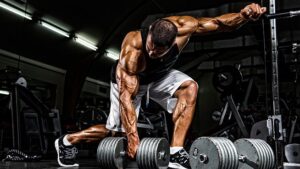Bodybuilding Workout
 The Art and Science of Bodybuilding Workouts
The Art and Science of Bodybuilding Workouts
Bodybuilding – sport and lifestyle that focuses on the intensive sculpting of the human body. It embodies an intricate blend of discipline, science, and art. Bodybuilding workout, far from being a monolithic or uniform regimen, is a continually evolving tapestry of exercises, methodologies, and philosophies.
The Philosophical Underpinnings
At its core, bodybuilding challenges individuals to surpass their physical and mental boundaries. Spartan discipline not only transforms the body but also instills virtues such as patience, perseverance, and self-confidence. Each workout is a step closer to an ideal, a relentless quest for improvement that mirrors life’s broader journey.
The Scientific Foundation
Central to bodybuilding workouts is an understanding of human anatomy and physiology. Muscle hypertrophy, the increase in muscle size, is achieved through meticulously designed resistance training that causes micro-tears in muscle fibers, which, when repaired, result in larger and stronger muscles. This scientific process underscores the importance of structured workouts that target different muscle groups with varying intensity, volume, and frequency.
Structuring a Bodybuilding Workout
A comprehensive bodybuilding workout is typically divided into routines that focus on specific muscle groups, such as chest, back, legs, arms, and shoulders. A balanced approach ensures that all parts of the body develop harmoniously, preventing imbalances and reducing the risk of injury. Exercises can be further categorized into compound movements, which engage multiple muscle groups and isolation movements, which target a single muscle group.
Most importantly
Periodization: The Key to Continuous Improvement
Periodization, the systematic planning of athletic training, involves varying a workout’s volume, intensity, and frequency over time. This method helps avoid plateaus, reduces the risk of overtraining, and ensures continual progress. A bodybuilder might cycle through phases of bulking (muscle building), cutting (fat loss), and maintenance, tailoring their workout intensity and volume—as well as their diet—to each phase’s specific goals.
Nutrition: The Unsung Hero of Muscle Building
Nutrition plays a pivotal role in bodybuilding, providing the essential building blocks for muscle repair and growth. A bodybuilding diet typically emphasizes high protein intake, moderate to high carbohydrates, and moderate fats, with adjustments made based on individual needs and the phase of training. Strategic meal timing, particularly around workouts, can significantly enhance muscle recovery and growth, making nutrition an integral component of the bodybuilding workout regimen.
The Role of Recovery
Recovery is as critical as the workouts themselves. Adequate rest, including sleep and active recovery days, allows muscles to repair and grow. Overlooking recovery can lead to overtraining, injuries, and setbacks. Incorporating practices such as stretching, foam rolling, and maybe even yoga can improve flexibility, reduce soreness, and enhance overall performance.
The Mental Game
Bodybuilding is as much a mental challenge as it is a physical one. Visualization, goal setting, and a positive mindset are paramount. The mental resilience developed through overcoming the rigors of training translates into other life arenas, making bodybuilders not just physically but mentally strong.
Conclusion: A Lifelong Journey
Bodybuilding is not merely a activity but a comprehensive lifestyle that encompasses physical, nutritional, psychological, and philosophical dimensions. The journey of bodybuilding is perpetual, with each workout contributing to the ongoing transformation of the body and mind. Bodybuilding workouts will continue to evolve, offering endless possibilities for those dedicated to the pursuit of physical excellence.
